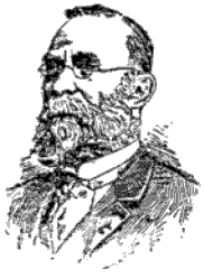Calvin M. Woodward facts for kids
Quick facts for kids
Calvin M. Woodward
|
|
|---|---|
 |
|
| Born |
Calvin Milton Woodward
August 25, 1837 Fitchburg, Massachusetts
|
| Died | January 12, 1914 (aged 76) St. Louis, Missouri
|
| Education | Harvard College |
| Occupation | Educator |
| Signature | |
Calvin Milton Woodward (born August 25, 1837 – died January 12, 1914) was an important American educator and professor. He was the dean of the engineering school at Washington University in St. Louis. There, he created a special program called "manual training." This program taught students how to use tools in a general way, not for a specific job. He later opened the St. Louis Manual Training School.
Contents
A Life of Learning and Service
Early Life and Education
Calvin Woodward was born in Fitchburg, Massachusetts. His parents were Isaac Burnap Woodward and Eliza W. (Wetherbee) Woodward. He was a bright student and graduated from Harvard College in 1860.
Teacher and Soldier
His first job was as the principal of Brown High School in Newburyport, Massachusetts. When the Civil War began, he joined the army. He became a captain in the 48th Massachusetts Infantry Regiment. He served for a year, from 1862 to 1863, in Louisiana. He was part of the siege of Port Hudson under General Nathaniel P. Banks. After his military service, he went back to being principal of Brown High School.
In 1863, he married Fanny Stone Balch. They had nine children together.
Moving to St. Louis
After the Civil War ended, Woodward moved to St. Louis. He became the vice principal of Smith Academy, which was part of Washington University. In 1868, he became an assistant professor of mathematics at Washington University. By 1870, he was a full professor of mathematics and applied mechanics. That same year, he also became the dean of the polytechnic school, which focused on technical subjects.
Pioneering Manual Training
The Idea of Manual Training
As dean, Woodward started to try out new ideas for teaching practical skills. In 1876, he saw a demonstration of a Russian method of tool instruction at a big exhibition in Philadelphia. This inspired him greatly. He began to plan and gather support for a similar program in the United States.
Opening the School
His efforts led to the opening of the St. Louis Manual Training School in 1879. This school was a part of Washington University. Woodward became the director of the school, even while keeping his other duties as dean.
The St. Louis Manual Training School was the first of its kind in the United States. It became a model for many other similar schools. Woodward's ideas about the goals and value of manual training had a big impact. They helped shape new ways of teaching both in the U.S. and in other countries. During the 1880s, the Manual Training School was the largest and most popular public high school in St. Louis.
What Was Manual Training?
The manual training system Woodward created was about teaching students how to use tools. Students learned by shaping wood or metal. However, the things they made were not meant to be sold. The main goal was to help students develop "mind-hand coordination." This meant learning to think carefully and use their hands skillfully at the same time.
Later Discussions on Education
Woodward gave many talks about manual training and his high school. However, by the late 1890s, manual training faced some criticism. Some people felt it didn't connect enough to the skills needed for specific jobs. Critics, like the National Association of Manufacturers, started to suggest a different system. They wanted "vocational education" that trained students for particular jobs, rather than general tool skills.
Other Achievements
Woodward was also active in other areas. He was a member of the St. Louis school board from 1878 to 1880. He was president of the St. Louis Engineer Club in 1883 and 1884. He led the industrial department of the National Educational Association from 1882 to 1884. In 1888, he was vice president of the American Association for the Advancement of Science.
In 1885, he was invited to give a speech about "Manual Training" at an education conference in Manchester, England. After that, he visited many schools and universities across Europe. Washington University gave him an honorary doctoral degree in Laws in 1882.
Calvin M. Woodward passed away in St. Louis on January 12, 1914.
Books by Calvin Woodward
Calvin Woodward wrote several important books about his ideas and work:
- History of St. Louis Bridge (1881)
- The Manual Training School (1887)
- Manual Training in Education (1890)
- Rational and Applied Mechanics (1912)
He also wrote many papers on mathematics and manual training for scientific magazines and other publications.
Images for kids


